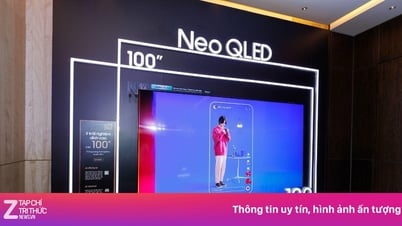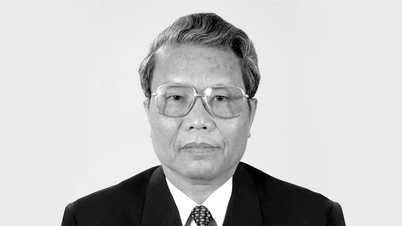Attending the Mobile World Congress (MWC) 2024 event, the Military Industry - Telecommunications Group ( Viettel ) introduced the 5G Digital Front End chip that controls the signal receiver block (5G DFE chip) to the world for the first time. This is one of the most complex chips "originating" in Vietnam.
A year later, also at the world's largest technology event, Viettel launched the Front End Module chip (FEM chip) - a component block that processes radio signals at the "front line" of transceivers such as broadcasting stations or telecommunications equipment.
 |
Viettel first introduced FEM chip at MWC 2025. |
“At MWC, corporations usually do not introduce individual chips, but solutions - computing processing chips associated with corresponding applications such as image processing, voice processing. However, we chose to demonstrate this product to prove that Vietnam has embarked on the semiconductor industry and has the first chips,” said Mr. Bui Viet Son - Viettel's semiconductor product introduction engineer at MWC Barcelona 2025 - at Viettel's booth. This place displays 22 "Made in Vietnam" technology products.
The world's supply of FEM chips currently depends on a few suppliers, while this is an indispensable component for the production of some radio transceivers.
“Starting with this product, Viettel's goal is to master each part of the radio equipment, starting with the important and popular components,” said Mr. Bui Viet Son.
Explaining further, the engineer said that mastering the chip design ensures that Vietnam's equipment production is not affected by global supply disruptions. In addition, this is a popular product, necessary in many devices, which will open up the possibility of commercializing Viettel's chip.
FEM chips are used in the fields of weather forecasting, monitoring, and communications. With a size of only 7x5 mm - as small as a bean, this chip can amplify radio signals. In active transceiver systems - FEM chips act as the heart to help detect and process signals quickly and accurately. Because of the specificity of this application, the chip requires the ability to operate day and night, for years, and remain stable.
 |
Successfully producing FEM chips, Viettel opens up export potential for Vietnam's semiconductor industry. |
For almost the entire year of 2024, the computer screen at Viettel Semiconductor Technology Department was always on, displaying measurement results from the chip design tool (license tool). In front of the screen, one of the four engineers in Viettel's FEM chip development team was always on duty to monitor the results. To have the chip applied in Viettel's devices as soon as possible, the team took turns running simulations 24/7, determined to solve a problem that not many organizations could do - "hand-designing" FEM chips. Although not new, this technology is not easy to master the design because semiconductor products are a secret that few people want to share.
As the product neared completion, a critical component of the chip developed a fault - the Power Amplifier (PA). The PA receives a low-power high-frequency signal and amplifies it to the required power level before sending it through the antenna, so it must be able to handle high power while maintaining high reliability. This component is especially important in radio communications where high transmit power is required.
Discovering a problem in the algorithm, the team quickly adjusted the design parameters. “The chip is not new, but this is the first time it has been researched and developed in Vietnam. Therefore, all technical factors are new. We have to research and learn from the simplest and most basic criteria,” said Mr. Do Thanh Tan - high-frequency microcircuit design engineer, FEM chip research team.
After many days of non-stop debugging, the results finally appeared: The chip operated at a stable capacity (5 Watt) and was equivalent to the world's FEM chips. At that time, Viettel's engineering team knew that they had made a new step forward in the journey to mastering radio monitoring equipment, 5G stations and high-frequency technologies.
“Initially, only 2 out of 5 chips worked stably. After many tests, we found the cause of the error and optimized the process, increasing the success rate to almost 100%,” said Mr. Do Thanh Tan.
Vietnam's semiconductor industry is estimated to have a market size of 31.39 billion USD by 2029 according to statistics from the Semiconductor Industry Association (SEMI). The successful development of strategic chips contributes to improving the self-sufficiency of radio equipment, while creating export opportunities - continuing to be the first step of the semiconductor industry in Vietnam.
Mr. Bui Viet Son said that when bringing the product to MWC Barcelona 2025 - where all major equipment suppliers in the mobile industry converge, the group hopes to introduce the product to wireless equipment manufacturers, thereby opening up new commercialization and market opportunities.
“The export potential of this product is huge, because the world currently has few commercial suppliers of FEM chips,” said Mr. Son.


![[Photo] Anh Hoang - Dinh Duc successfully defended the men's doubles championship of the National Table Tennis Championship of Nhan Dan Newspaper](https://vphoto.vietnam.vn/thumb/1200x675/vietnam/resource/IMAGE/2025/5/23/d6ab3bcac02c49928b38c729d795cac6)




![[Photo] Top players gather at the 2025 Nhan Dan Newspaper National Table Tennis Championship](https://vphoto.vietnam.vn/thumb/1200x675/vietnam/resource/IMAGE/2025/5/23/9ad5f6f4faf146b08335e5c446edb107)





















































































Comment (0)